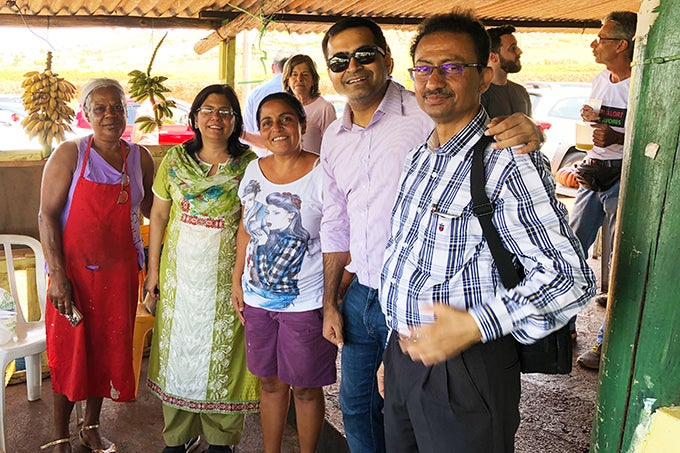
“Once, it was a rodeo day here and my son asked for money to go. But I didn’t have the money and told him to sell our farm’s bananas on the road instead. So, he took 50 bunches of bananas and sold them all in a few hours. Soon I started a banana business. The sales enabled me to expand my business to packed lunches for truckers. Over time, with the help of my family, the road administration, and my own investments, I started receiving invitations to make meals for college students and travelers.”
Angela, small-holder farmer and entrepreneur, São Paolo, Brazil.
Angela told us her story one afternoon as we ate the delicious lunch she had prepared for us at her rather humble roadside eatery in rural São Paulo, Brazil.
Her story was not only touching but also summed up the importance of entrepreneurial foresight and the power that collaboration holds in opening new doors for poor farming communities.
India and Brazil have much in common. Both have smallholder farmers - called family farmers in Brazil - (although these farmers make up a much smaller proportion of Brazil’s overall farming community and have a different landholding structure).
Yet Brazil, like many other Latin American countries, has been able to promote commercial agriculture and raise farmers’ incomes by creating collectives, comprised mainly of family farmers.
Even though family farmers represent a small slice of Brazil’s cooperatives, the impact of their collectives is considerable.
Often referred to as the “breadbasket of the world”, half of Brazil’s food comes from its 1,500 plus agricultural co-operatives, which employ more than 360,000 people.
The productivity of Brazil’s agriculture is evident.
With only 15% of Brazil’s population living in rural areas, more than 20% of its GDP comes from the agriculture sector.
In India, on the other hand, 66% of the people live in rural areas while just 15% of GDP comes from agriculture.
Brazil’s success in making agriculture more market-oriented and raising farmer incomes holds many lessons for India.
For many years now, India has recorded a surplus in most critical agricultural commodities.
Yet, farmers’ incomes continue to be subdued.
To help farmers earn more from the land and move onto a higher trajectory of growth, India has gradually shifted its policy focus to linking farmers to markets, as well as enabling them to diversify their production and add value to their produce.
So how do Brazil’s farmer collectives work?
In what Brazil, like many other Latin American countries, calls the 'productive alliance', an alliance is formed between farmers and their collectives with the private sector and the government.
Such an alliance helps farmers better align their production with market demand and reduce the number of intermediaries in the value chain.
Because they are bigger and stronger than individual farmers, the collectives are also able to install major post-harvest infrastructure to help with value addition.
To learn from this experience and to promote the competitiveness of smallholder farmers in Jharkhand, a team from India visited the Brazilian state of Sao Paulo in September end as part of a South-South knowledge exchange visit.
The team comprised of policymakers from the Government of Jharkhand and officials from the World Bank connected to two projects - the Jharkhand Opportunities for Harnessing Rural Growth Project (JOHAR) and the National Rural Economic Transformation Project (NRETP).

The Indian team visited one of Brazil’s most successful projects– Microbacias II – being implemented by the State Departments of Agriculture and Environment. In the last six years, the project has benefited 266 agricultural cooperatives and around 8,000 smallholder farmers, with impressive results.
For instance, in Ibiúna, a small city in the metropolitan region, a vegetable cooperative has been able to expand its reach to over 21 retailers and supermarket chains in the country.
Similarly, in Divinolândia, an organization of 19 smallholder coffee producers has not only acquired machinery and warehouse facilities for processing coffee but has also established strong market linkages in Europe, USA, and other countries under the fair-trade mechanism.
Productive Alliance projects like Microbacias II usually use a competitive mechanism for selecting cooperatives. This competition has built-in marketing plans, financing options and details of the `Alliance’ between various stakeholders.
The project also placed great emphasis on high-quality warehousing, processing, and cold storage facilities, which were crucial in making the farmers competitive in the market.
Furthermore, stakeholders like the São Paulo General Warehouses Company (CEAGSP), a federal company linked to Brazil’s Ministry of Agriculture, provide crucial services in the fruit and vegetable value chain.
CEAGSP sets standards that enable farmers to compare their products with established benchmarks. The company also monitors and forecasts price and market behaviors of wholesalers and retailers for the benefit of producers.
In addition, Brazil has several policies and programs to strengthen family farming, such as subsidized credits to promote low carbon agriculture, a regulation mandating 30 percent of the budget to schools and other government institutions to be invested in the direct purchase of family farm products and attractive financing schemes for export-oriented producers and enterprises.
To conclude, the trip was memorable, with important learnings that can be piloted in Jharkhand and other agriculture and rural transformation programs in India.



Join the Conversation